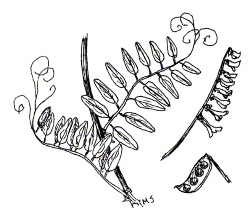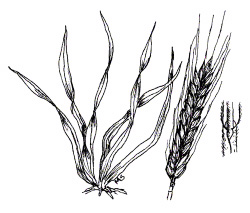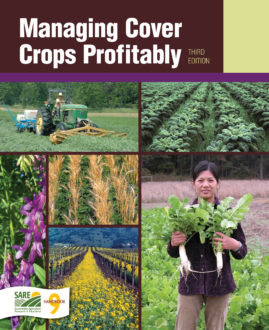by Marianne Sarrantonio
Cover crops provide many benefits, but they’re not do-it-all “wonder crops.” To find a suitable cover crop or mix of covers:
- Clarify your primary needs
- Identify the best time and place for a cover crop in your system
- Test a few options
This book makes selection of cover crops a little easier by focusing on some proven ones. Thousands of species and varieties exist, however. The steps that follow can help you find crops that will work best with a minimum of risk and expense.
1. Identify Your Problem or Use of Cover Crops
Review Benefits of Cover Crops to decide what you want most from a cover crop. Narrowing your goals to one or two primary and perhaps a few secondary goals will greatly simplify your search for the best cover species. Some common goals for cover crops are to:
- Provide nitrogen
- Add organic matter
- Improve soil structure
- Reduce soil erosion
- Provide weed control
- Manage nutrients
- Furnish moisture-conserving mulch
You might also want the cover crops to provide habitat for beneficial organisms, better traction during harvest, faster drainage or another benefit.

2. Identify the Best Place and Time to use Cover Crops
Sometimes it’s obvious where and when to use a cover crop. You might want some nitrogen before a corn crop, or a perennial ground cover in a vineyard or orchard to reduce erosion or improve weed control. For some goals, such as building soil, it may be hard to decide where and when to schedule cover crops.
To plan how and where to use cover crops, try the following exercise:
Look at your rotation. Make a timeline of 18 to 36 monthly increments across a piece of paper. For each field, pencil in current or probable rotations, showing when you typically seed crops and when you harvest them.
If possible, add other key information, such as rainfall, frost-free periods and times of heavy labor or equipment demand.
Look for open periods in each field that correspond to good conditions for cover crop establishment, underutilized spaces on your farm, as well as opportunities in your seasonal work schedule. Also consider ways to extend or overlap cropping windows.
Here are examples of common niches in some systems, and some tips:
Winter fallow niche. In many regions, seed winter covers at least six weeks before a hard frost. Winter cereals, especially rye, are an exception and can be planted a little later. If ground cover and N recycling needs are minimal, rye can be planted as late as the frost period for successful overwintering.
You might seed a cover right after harvesting a summer crop, when the weather is still mild. In cooler climates, consider extending the window by overseeding (some call this undersowing) a shade-tolerant cover before cash crop harvest. White clover, annual ryegrass, rye, hairy vetch, crimson clover, red clover and sweetclover tolerate some shading.
If overseeding, irrigate afterwards if possible, or seed just before a soaking rain is forecast. Species with small seeds, such as clovers, don’t need a lot of moisture to germinate and can work their way through tiny gaps in residue, but larger-seeded species need several days of moist conditions to germinate.
When overseeding into cash crops early in the season, vigorous growth of the cover crop may cause water stress, increase disease risks due to lower air circulation or create new insect pest risks. Changing cover crop seeding rate, seeding time, or the rotation sequence may lessen this risk. To ensure adequate sunlight for the cover crop, overseed before full canopy closure of the primary crop (at last cultivation of field corn, for example) or just before the canopy starts to open again as the cash crop starts to die (as soybean leaves turn yellow, for example).
Expect excessive field traffic around harvest time? Choose tough, low-growing covers such as grasses or clovers. Limit foot traffic to alternate rows, or delay a field operation to allow for cover crop establishment.
Another option could be to use a reseeding winter annual that dies back and drops seed each summer but reestablishes in fall. Subclovers reseed well in regions south of Hardiness Zone 6. Shorter-season crimson clovers—especially varieties with a high hard-seed percentage that germinate over an extended period—work well in the Southeast where moisture is sufficient. Even rye and vetch can reseed if managed properly.
Summer fallow niche. Many vegetable rotations present cover crop opportunities—and challenges. When double cropping, you might have fields with a three- to eight-week summer fallow period between early planted and late planted crops. Quick-growing summer annuals provide erosion control, weed management, organic matter and perhaps some N.
Consider overseeding a spring crop with a quick-growing summer grain such as buckwheat, millet or sorghum-sudangrass, or a warm-season legume such as cowpeas. Or, you might till out strips in the cover crop for planting a fall vegetable crop and control the remaining cover between the crop rows with mowing or light cultivation.
Small grain rotation niche. Companion seed a winter annual cover crop with a spring grain, or frost seed (broadcasting seed onto frozen ground) a cover into winter grains. Soil freezing and thawing pulls seed into the soil and helps germination. Another option if soil moisture isn’t a limiting factor in your region: broadcast a cover before the grain enters boot stage (when seedheads start elongating) later in spring or plant after harvest.
Full-year improved fallow niche. To rebuild fertility or organic matter over a longer period, perennials or biennials—or mixtures—require the least amount of maintenance. Spring -seeded yellow blossom sweetclover flowers the following summer, has a deep taproot and gives plenty of aboveground biomass. Also consider perennial forages recommended for your area .The belowground benefit of a tap rooted perennial can have tremendous soil improving benefits when allowed to grow for several years.
Another option is sequential cover cropping. Plant hairy vetch or a grass-legume mixture in fall, terminate it the following spring at flowering, and plant sorghum-sudangrass. The winter cover crop provides weed suppression and ground cover, but also nitrogen for the high-N sorghum-sudangrass, which can produce tons of biomass to build soil organic matter.
Properly managed, living mulches give many growers year-round erosion protection, weed control, nutrient cycling and even some nitrogen if they include a legume. Some tillage, mowing or herbicides can help manage the mulch (to keep it from using too much soil moisture, for example) before crops are strip-tilled into the cover or residue. White clover could be a good choice for sweet corn and tomatoes. Perennial ryegrass or some less aggressive turfgrasses such as sheep fescue may work for beans, tomatoes and other vegetables.
Create new opportunities. Have you honed a rotation that seems to have few open time slots? Plant a cover in strips the width of a bed or wider, alternating with your annual vegetable, herb or field crop. Switch the strips the next year. Mow the strips periodically and blow the topgrowth onto adjoining cash crops as mulch. In a bed system, rotate out every third or fourth bed for a soil-building cover crop.
Another option: Band a cover or some insect attracting shrubs around fields or along hedgerows to suppress weeds or provide beneficial habitat where you can’t grow cash crops. These hedgerows could also be used to produce marketable products such as nuts, berries or even craft materials.

3. Describe the Cover Crop Niche
Refer to your timeline chart and ask questions such as:
- How will I seed the cover?
- What’s the weather likely to be then?
- What will soil temperature and moisture conditions be like?
- How vigorous will other crops (or pests) be?
- Should the cover be low-growing and spreading, or tall and vigorous?
- What weather extremes and field traffic must it tolerate?
- Will it winterkill in my area ?
- Should it winterkill, to meet my goals?
- What kind of regrowth can I expect?
- How do I kill it and plant into it?
- Will I have the time to make this work?
- What’s my contingency plan—and risks—if the crop doesn’t establish or doesn’t die on schedule?
- Do I have the needed equipment and labor?
4. Select the Best Cover Crop
You have identified a goal, a time and a place, now specify the traits a cover crop would need to work well.
Example 1. A sloping orchard needs a ground cover to reduce erosion. You’d like it to contribute N and organic matter and attract beneficial organisms but not rodents, nematodes or other pests. The cover can’t use too much water or tie up nutrients at key periods. Too much N might stimulate excessive tree leaf growth or prevent hardening off before winter. Finally you want a cover crop that is easy to maintain. It should:
- be a perennial or reseeding annual
- be low-growing, needing minimal management
- use water efficiently
- have a soil-improving root system
- release some nutrients during the year, but not too much N
- not harbor or attract pests
For this orchard scenario, white clover is probably the best option north of Zone 8. A mixture of low-growing legumes or a legume and grass mix could also work. In warm regions, low-growing clovers such as strawberry clover and white clover work well together, although these species may attract pocket gophers. BLANDO brome and annual ryegrass are two quick-growing, reseeding grasses often suitable for orchard floors, but they will probably need some control with mowing. Or, try a reseeding winter annual legume such as crimson clover, rose clover, subclover, an annual vetch or an annual medic, depending on your climate.
Example 2. A dairy lacks adequate storage in fall and winter for the manure it generates, which exceeds the nutrient needs for its silage corn and grass/legume hay rotation. The cover crop needs to:
- establish effectively after (or tolerate) silage corn harvest
- take up a lot of N and P from fall-applied manure and hold it until spring
For this dairy scenario, rye is usually the best choice. Other cereal grains or brassicas could work if planted early enough.
Example 3. In a moderate rainfall region after small grain harvest in late summer, you want a soil-protecting winter cover that can supply N for no-till corn next spring. You want to kill the cover without herbicides. You need a legume that:
- can be drilled in late summer and put on a lot of fall growth
- will overwinter
- will fix a lot of N
- can be mow-killed shortly before (or after) corn planting
- could provide some weed-controlling, moisture-conserving residue
Hairy vetch works well in the Northeast, Midwest and parts of the mid-South. Mixing it with rye or another cereal improves its weed-management and moisture-conservation potential. Crimson clover may be an appropriate choice for the southeastern Piedmont. Austrian winter pea could be considered, alone or in a mix, in coastal plain environments, but will winterkill in Zone 7 and below. Where grain harvest occurs in late spring or early summer, LANA woollypod vetch might be a better choice.
Example 4. After a spring broccoli crop, you need a weed-suppressing cover that adds N and organic matter, and perhaps mulch, into which you will no-till seed fall lettuce or spinach. You want a cover that:
- is very versatile
- grows fast in hot weather
- can be overseeded into broccoli
- germinates on the soil surface under dry conditions
- fixes N
- persists until you’re ready to kill it
Here, a quick-growing, warm-season legume such as cowpeas may work, especially if you can irrigate to hasten establishment during dry conditions.
5. Settle for the Best Available Cover Crop. It’s likely the “wonder crop” you want doesn’t exist. One or more species could come close, as the above examples indicate. Top Regional Cover Crop Species can provide a starting point. Check with regional experts. Keep in mind that you can mix two or more species, or try several options in small areas.
6. Or Build a Rotation Around Cover Crops. It’s hard to decide in advance every field’s crops, planting dates, fieldwork or management specifics. One alternative is to find out which cover crops provide the best results on your farm, then build a rotation around those covers, especially when trying to tackle some tough soil improvement or weed control issues. See Full-Year Covers Tackle Tough Weeds.
With this “reverse” strategy, you plan covers according to their optimum field timing, and then determine the best windows for cash crops. A cover crop’s strengths help you decide which cash crops would benefit the most.
For now, however, you probably want to fit one or more cover crops into your existing rotations. The charts and narratives in this book can help you select some of the most suitable species for your farming system and objectives. See Crop Rotations with Cover Crops to get you thinking more. When you’ve narrowed your choices, refer to Appendix A, Testing Cover Crops on Your Farm for some straightforward tips on what to do next.
Adapted from Northeast Cover Crop Handbook by Marianne Sarrantonio, Rodale Institute, 1994.
